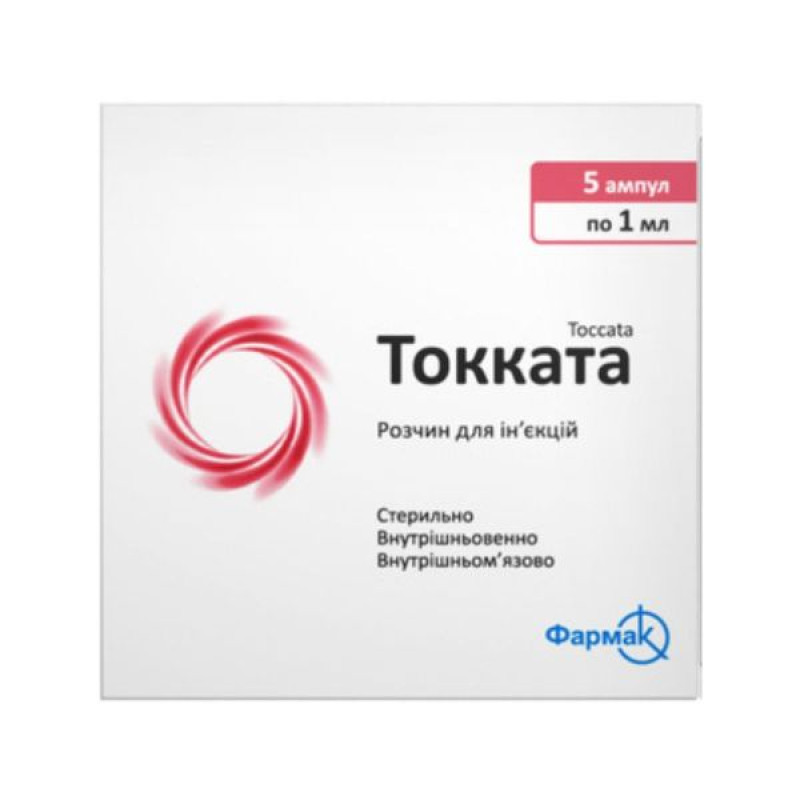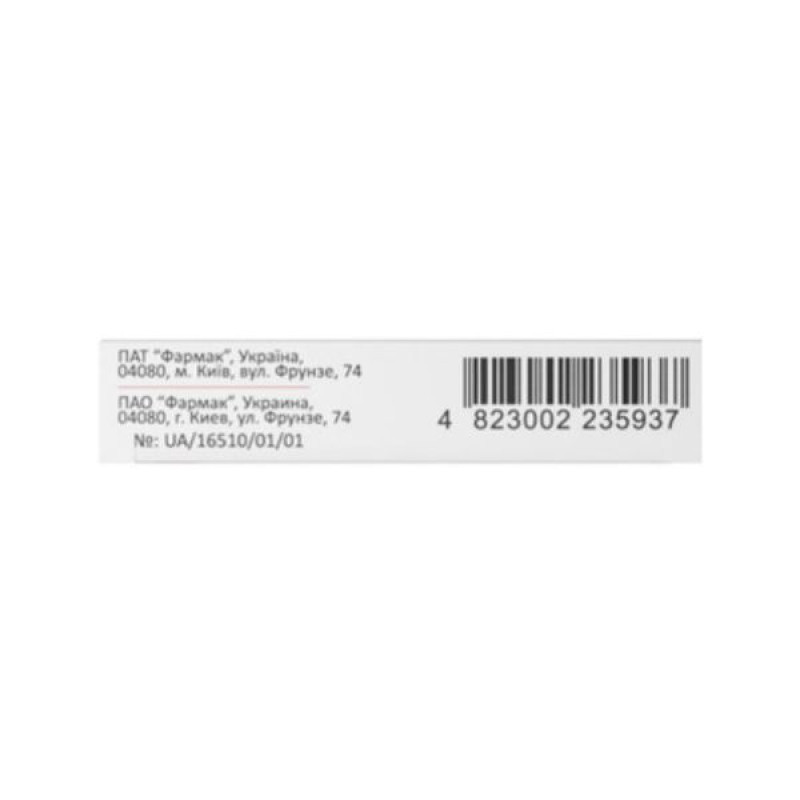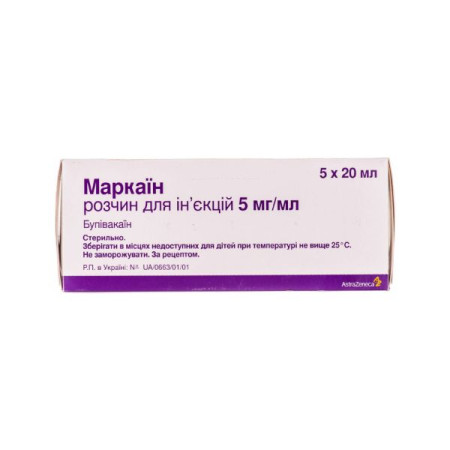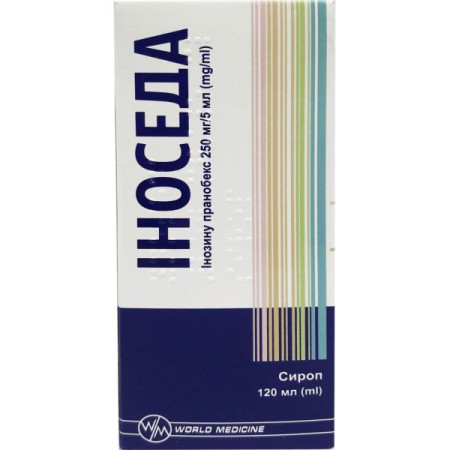Toccata solution for injection ampoule 1 ml blister No. 5

Instructions for Toccata solution for injection ampoule 1 ml blister No. 5
Composition
active ingredients: tolperisone hydrochloride, lidocaine hydrochloride;
1 ml of solution contains: tolperisone hydrochloride – 100 mg, lidocaine hydrochloride – 2.5 mg;
excipients: methylparaben (E 218), diethylene glycol monoethyl ether, 0.1 M solution
hydrochloric acid, water for injections.
Dosage form
Solution for injection.
Main physicochemical properties: clear, colorless or greenish liquid.
Pharmacotherapeutic group
Muscle relaxants with a central mechanism of action.
ATX code M03V X04.
Pharmacological properties
Pharmacodynamics.
Centrally acting muscle relaxant. The exact mechanism of action is unknown. As a result of its membrane-stabilizing and local anesthetic action, it prevents the conduction of excitation in primary afferent fibers, blocking mono- and polysynaptic reflexes of the spinal cord. The secondary mechanism of action is to block the release of the transmitter by blocking the influx of calcium ions into the synapse.
Reduces reflex readiness in the reticulospinal pathways of the brainstem. Reduces increased muscle tone and rigidity, which are caused by decerebration of animals during the experiment.
Increases peripheral blood circulation. This effect is not associated with the drug's effect on the central nervous system. It may be due to the weak antispasmodic and antiadrenergic effects of tolperisone.
Pharmacokinetics.
It is extensively metabolized in the liver and kidneys. It is excreted by the kidneys, more than 99% - in the form of metabolites. The pharmacological activity of the metabolites is unknown. With intravenous administration, the half-life is approximately 1.5 hours.
Indication
Muscle spasticity, including post-stroke spasticity, in cases where the injectable form is the method of choice.
Contraindication
Hypersensitivity to the active substances or to eperisone, which is chemically similar to tolperisone, as well as to any of the excipients and to other amide local anesthetics.
Myasthenia gravis.
Breastfeeding period.
Childhood.
Interaction with other medicinal products and other types of interactions
Pharmacokinetic studies of drug interactions with dextromethorphan, a CYP2D6 substrate, have demonstrated that co-administration of tolperisone increases plasma concentrations of drugs that are predominantly metabolized by cytochrome CYP2D6, including thioridazine, tolterodine, venlafaxine, atomoxetine, desipramine, dextromethorphan, metoprolol, nebivolol, and perphenazine.
In vitro studies in human liver microsomes and hepatocytes did not reveal any significant inhibition or induction of other CYP isoenzymes (CYP2B6, CYP2C8, CYP2C9, CYP2C19, CYP1A2, CYP3A4).
It is expected that co-administration with other CYP2D6 substrates and/or other drugs will not increase exposure to tolperisone, which is due to the diversity of tolperisone metabolic pathways.
Although tolperisone is a centrally acting drug, the likelihood of developing a sedative effect when using it is low. In the case of simultaneous administration with other centrally acting muscle relaxants, it is necessary to consider reducing the dose of tolperisone.
Tolperisone potentiates the effects of niflumic acid, therefore, when taken simultaneously with tolperisone, the dose of niflumic acid, as well as other NSAIDs, should be reduced.
Application features
The injectable form of the drug should not be administered to children.
Hypersensitivity reactions.
During post-marketing surveillance, the most frequently reported hypersensitivity reactions with tolperisone were: hypersensitivity reactions. Their severity ranged from mild skin reactions to severe systemic reactions, including anaphylactic shock. Symptoms of hypersensitivity reactions may include erythema, rash, urticaria, pruritus, angioedema, tachycardia, hypotension or dyspnoea.
Women with a history of hypersensitivity to other drugs or allergic conditions are at higher risk of hypersensitivity reactions when taking tolperisone.
Patients should be aware of the possibility of allergic reactions. If symptoms of allergy occur, tolperisone should be discontinued and medical attention should be sought immediately.
After an episode of hypersensitivity to tolperisone, the drug should not be re-administered.
The drug contains lidocaine, therefore, in case of known hypersensitivity to lidocaine, as well as to other amide local anesthetics, Toccata for injection should not be used due to the possibility of developing cross-allergic reactions.
The drug contains methylparaben (E 218), which may cause allergic reactions (possibly delayed), and in some cases - bronchospasm.
Use during pregnancy or breastfeeding
According to animal studies, tolperisone does not have a teratogenic effect.
The use of the drug in the first trimester of pregnancy is contraindicated.
Given the lack of significant clinical data, the use of Toccata in the II and III trimesters of pregnancy is possible when, in the opinion of the doctor, the expected benefit significantly outweighs the potential risk to the fetus/child.
Ability to influence reaction speed when driving vehicles or other mechanisms
Given the possibility of developing symptoms such as dizziness, drowsiness, impaired attention, epilepsy, blurred vision, the drug should be used with caution when driving or working with other mechanisms.
Method of administration and doses
For parenteral administration only.
For adults only. Administer the drug intramuscularly at 100 mg twice daily or as a slow intravenous injection at 100 mg once daily.
The injection solution should not be used in children.
The duration of treatment is determined by the doctor depending on the nature of the disease and the effectiveness of the treatment.
Children
Toccata injection solution should not be used in children.
Overdose
Data on overdose with Toccata are limited. Toccata has a wide therapeutic index. A dose of 600 mg administered orally to children has not been reported to cause serious symptoms of overdose.
Irritability has been observed when 300–600 mg/day was administered orally to children. In nonclinical acute toxicity studies, administration of high doses caused ataxia, tonic-clonic convulsions, respiratory distress, and arrest.
There is no specific antidote for tolperisone. In case of overdose, symptomatic and supportive treatment is recommended.
Adverse reactions
Adverse reactions are listed by system organ class according to the MedDRA Medical Dictionary of Regulatory Activities using the following MedDRA frequency definitions: very common (≥ 1/10), common (≥ 1/100, <1/10), uncommon (≥ 1/1,000, <1/100), rare (≥ 1/10,000, <1/100), very rare (<1/10,000), unknown frequency (cannot be estimated from the available data).
According to post-marketing surveillance, approximately 50-60% of adverse reactions associated with tolperisone are hypersensitivity reactions. Most of these reactions were minor and self-limiting. Life-threatening hypersensitivity reactions have occurred in isolated cases.
| Organ system classes | Common (≥1/100, <1/10) | Infrequently (≥1/1000, <1/100) | Rarely (≥1/10000, <1/1000) | Very rare (<1/10000) |
| Blood and lymphatic system disorders | Anemia Lymphadenopathy | |||
| On the part of the immune system | Hypersensitivity reaction Anaphylactic reaction | Anaphylactic shock | ||
| Nutritional and metabolic | Anorexia | Polydipsia | ||
| Mental disorders | Insomnia Sleep disturbances | Decreased activity Depression | Confusion of consciousness | |
| From the nervous system | Headache Dizziness Drowsiness | Attention deficit disorder Tremor Convulsions Hypoesthesia Paresthesia Lethargy (increased drowsiness) | ||
| From the organs of vision | Vision impairment | |||
| Hearing and balance disorders | Tinnitus Vertigo (dizziness) | |||
| From the heart | Angina pectoris Tachycardia Rapid heartbeat Lowering blood pressure | Bradycardia | ||
| From the vascular system | Hypotension | Skin hyperemia | ||
| Respiratory, thoracic and mediastinal disorders | Difficulty breathing Nosebleed Dyspnea | |||
| Gastrointestinal tract | Feeling of discomfort in the stomach Diarrhea Dryness of the oral mucosa Dyspepsia Nausea | Epigastric pain Constipation Flatulence Vomiting | ||
| Liver and biliary tract disorders | Mild liver damage | |||
| Skin and subcutaneous tissue disorders | Allergic dermatitis Hyperhidrosis Itch Urticaria Rash | |||
| Musculoskeletal and connective tissue disorders | Muscle weakness Myalgia Pain in the extremities | Feeling of discomfort in the extremities | Osteopenia | |
| Renal and urinary tract disorders | Enuresis Proteinuria | |||
| General disorders and administration site conditions | Redness at the injection site | Asthenia Discomfort Increased fatigue | Feeling intoxicated Feeling hot Irritability Thirst | Feeling of discomfort in the chest |
| Laboratory indicators | Lowering blood pressure Increased bilirubin concentration in the blood Change in liver enzyme activity Decreased platelet count Leukocytosis | Increased creatinine concentration in the blood |
Frequency not known (cannot be estimated from the available data) - changes in the site of drug administration.
Expiration date
Do not use the drug after the expiration date indicated on the package.
Storage conditions
Store in the original packaging at a temperature of +2°C to +8°C.
Do not freeze.
Keep out of reach of children.
Incompatibility.
Data on compatibility studies are not available, therefore Toccata should not be mixed with other drugs in the same syringe. Administer separately from other drugs.
Packaging
1 ml in ampoules. 5 ampoules in a blister; 1 or 2 blisters in a pack.
Vacation category
According to the recipe.
Producer
JSC "Farmak".
Location of the manufacturer and its business address
Ukraine, 04080, Kyiv, Kyrylivska St., 74.
There are no reviews for this product.
There are no reviews for this product, be the first to leave your review.
No questions about this product, be the first and ask your question.













